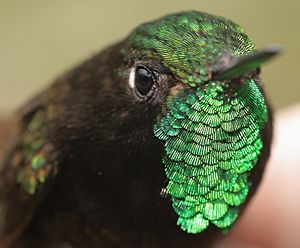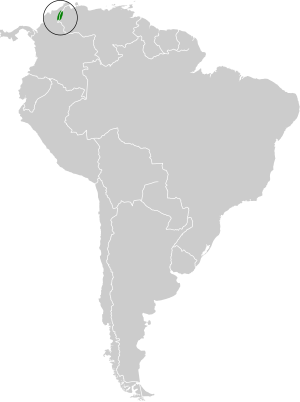Perijá metaltail facts for kids
Quick facts for kids Perijá metaltail |
|
|---|---|
 |
|
| Conservation status | |
| Scientific classification | |
| Genus: |
Metallura
|
| Species: |
iracunda
|
 |
|
The Perijá metaltail (Metallura iracunda) is a special kind of hummingbird. It is found in the mountains of Colombia and Venezuela. This tiny bird is currently listed as an Endangered species. This means it is at high risk of disappearing forever.
Contents
What is the Perijá Metaltail?
Bird Family and Relatives
The Perijá metaltail belongs to a group of hummingbirds called "coquettes." It is the only species in its specific group, meaning it is monotypic. This means it's the only one of its kind in its genus. It is closely related to another hummingbird called the Tyrian metaltail. Sometimes, these two birds can even be found living in the same areas.
How to Identify a Perijá Metaltail
The Perijá metaltail is a small bird, about 10 to 11 cm (4 inches) long. It weighs only about 3.6 to 4.1 grams (0.13 ounces). That's lighter than a few paper clips! It has a short, straight, black beak.
Male and Female Birds
The adult male Perijá metaltail has a very dark, almost black, body with a hint of gold on its upper parts. Its chest and belly are a dark bronzy green with shiny gold spots. It has a bright emerald green patch on its throat, called a gorget. Its tail is a beautiful, sparkling ruby red and is slightly forked.
The adult female is also dark on top. Her throat and upper chest are a mix of orange and brown with olive green spots. Her lower chest and belly are a rich, creamy color with more green spots. The tips of her outer tail feathers are a light, buffy color. Young birds look similar to the adult females.
Where Does the Perijá Metaltail Live?
Geographic Location and Habitat
This special hummingbird lives in the Serranía del Perijá mountain range. This mountain range is located right on the border between northern Colombia and northwestern Venezuela.
The Perijá metaltail lives in many different types of places within these mountains. It can be found in open, bushy areas, misty "elfin forests," and even bamboo patches. It also lives in grassy areas called páramo and places with sandstone rocks. In Colombia, it lives at heights between 2,400 and 3,200 meters (7,900 to 10,500 feet) above sea level. In Venezuela, it can be found a bit lower, at about 1,850 meters (6,070 feet).
Perijá Metaltail Behavior
Movement and Daily Life
Scientists believe the Perijá metaltail stays in one area and does not migrate. This means it is a sedentary bird. Not much is known about what it eats or how it finds its food. We also don't know much about its breeding habits or how it raises its young.
Bird Sounds and Calls
The specific sounds and calls of the Perijá metaltail have not been fully described by scientists. However, there are some recordings of its sounds available. You can find these recordings on websites like Xeno-canto and Cornell University's Macaulay Library.
Why is the Perijá Metaltail Endangered?
Conservation Status and Threats
The IUCN (International Union for Conservation of Nature) keeps track of endangered species. They first listed the Perijá metaltail as "Near Threatened." Then, in 2000, it became "Vulnerable." Since 2004, it has been listed as "Endangered."
This means the Perijá metaltail is in serious trouble. Its special home, called its habitat, is very small and is shrinking. The main reasons for this are:
- Habitat Loss: The places where it lives are being destroyed or changed.
- Mining: Activities like mining can harm the environment where these birds live.
- Smuggling: Illegal activities, like capturing and selling birds, can also hurt their populations.
All these problems make it harder for the Perijá metaltail to survive and thrive in its mountain home.
See also
 In Spanish: Colibrí de Perijá para niños
In Spanish: Colibrí de Perijá para niños


